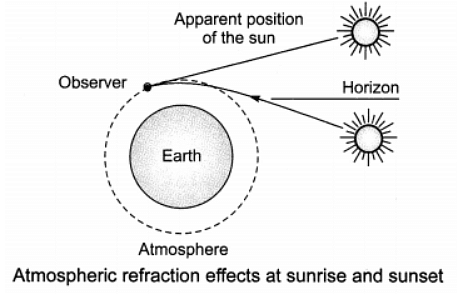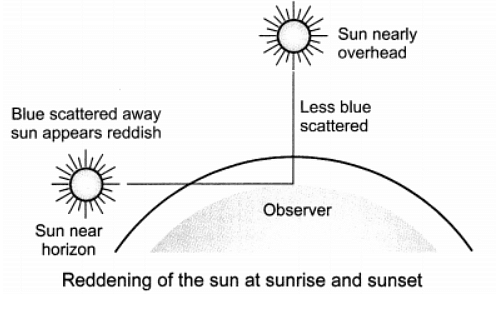Class 10 Science Chapter 10 Question Answers - The Human Eye and the Colourful World
Q1: What is meant by advance sunrise and delayed sunset? Draw a labelled diagram to explain these phenomena.
Ans: Advance sunrise and delayed sunset is due to atmospheric refraction.
When the sun is slightly below the horizon, the sunlight coming from the less dense (vacuum) to more dense (air) medium is refracted downwards. So the sun appears to be above the horizon.
Similarly, even after actual sunset, the sun can be seen for a few minutes due to refraction of sunlight.
Q2: Explain formation of rainbow.
Ans: Rainbow formation: A rainbow is a natural spectrum appearing in the sky after rain shower. It is caused by dispersion of sunlight by tiny water droplets, present in the atmosphere. The water droplets act like small prism. They refract and disperse the incident sunlight, then reflect it internally and finally refract it again.
Rainbow formation: A rainbow is a natural spectrum appearing in the sky after rain shower. It is caused by dispersion of sunlight by tiny water droplets, present in the atmosphere. The water droplets act like small prism. They refract and disperse the incident sunlight, then reflect it internally and finally refract it again.
Due to dispersion of light and internal reflection different colours appear.
Q3: Explain the refraction of light through a triangular glass prism using a labelled ray diagram. Hence define the angle of deviation.
Ans: Refraction of light through prism: PE – Incident ray
PE – Incident ray
EF – Refracted ray
FS – Emergent ray
∠A – Angle of the prism
∠i – Angle of incidence
∠r – Angle of refraction
∠e – Angle of emergence
∠D – Angle of deviation
Refraction of light through a triangular glass prism:
- The refraction of light takes place at two surfaces firstly when light enters from air to prism and secondly when light emerges from prism.
- Angle of prism: The angle between the two lateral faces of the prism is called angle of prism.
- Angle of deviation: The angle between incident ray (produced forward) and emergent ray (produced backward).
Q4: What is the difference in colours of the sun observed during sunrise/sunset and noon? Give explanation for each.
Ans: In the morning and evening, the sun lies near the horizon. Sunlight travels through a larger distance in the atmosphere and most of the blue light and shorter wavelengths are scattered away by the particles. Therefore, the light that reaches our eyes is of longer wavelength. This gives rise to the reddish appearance of the sun.
At noon sun appears white as only a little of blue and voilet colours are scattered.
Q5: Define the term dispersion of white light. Name the colour of light which bends (i) the most, (ii) the least, while passing through a glass prism. Draw a ray diagram to justify your answer.
Ans: Dispersion of white light by a glass prism
Dispersion: The splitting of light into its component colours is called dispersion.
The red light bends the least while violet bends the most.
Spectrum: The band of the coloured components of a light beam is called spectrum.
i.e., VIBGYOR
Q6: Explain twinkling of stars.
Ans: Twinkling of stars:
- The twinkling of stars is due to atmospheric refraction of starlight.
- When starlight enters the earth’s atmosphere, it suffers refraction continuously. Since the physical conditions of the earth’s atmosphere are not stationary the stars appear twinkling.

Q7: What is the role of the ciliary muscles?
Ans: The main role of the ciliary muscles is to hold the eye lens in its position. The ciliary muscles contract and relax to focus on near or far away objects by changing the shape of the eye lens which in turn increases or decreases the focal length of the eye lens.
Q8: Why is a convex lens called a converging lens?
Ans: A convex lens focuses all the parallel light rays at its focus after refraction. Hence, it is called a converging lens.
Q9: State the role of the eye lenses in the human eye?
Ans: The eye lens focuses the light rays entering the eye on the retina forming a real and an inverted image of the object on the retina.
Q10: A person with a myopic eye cannot see objects beyond 1.2 m distinctly. What should be the corrective lens used to restore proper vision?
Ans: Since the person is myopic and cannot see objects clearly beyond 1.2 m, he should use a concave lens having a focal length 1.2 m to restore his normal vision.
Q11: What is the far point and near the point of the human eye with normal vision?
Ans: For a human eye with proper vision, the near point is 25 cm from the eye and the far point is at infinity.
Q12: A student has difficulty reading the blackboard while sitting in the last row. What could be the defect the child is suffering from? How can it be corrected?
Ans: Since, the student has difficulty reading the blackboard, sitting in the last row, he is suffering from myopia or short-sightedness. A concave lens of suitable power should be used to correct his vision defect.
Q13: Why is a normal eye not able to see clearly the objects placed closer than 25 cm?
Ans: The normal eye is unable to see the objects clearly placed closer than 25 cm because at a distance of 25 cm power of accommodation gets exhausted. Hence, the eye is unable to focus the light rays on the retina, when the object is placed closer than 25 cm.
Q14: Why does the Sun appear reddish early in the morning?
Ans: During sunrise, the sun is at the farthest distance from the earth’s surface. The light rays travel a large distance in the Earth’s atmosphere before reaching our eyes.
While passing through the atmosphere, the light rays with shorter wavelengths get scattered by the Earth’s atmosphere and the red-colored light with the longest wavelength is able to reach our eyes. Hence, the Sun appears reddish early in the morning.
Q15: Why do we observe random wavering or flicking of the objects near a fire or on a very hot day?
Ans: We observe random wavering or flicking of the objects near a fire or on a very hot day because of atmospheric refraction. The area above the fire is hot and is lighter than the cool air above it due to which its refractive index is low and density also does not remain the same. Therefore, the apparent position of the object flickers.
Q16: Why are we not able to see things clearly when we come out of a dark room?
Ans: In a dark room, the iris expands the pupil which allows more light to enter the eye. As we come out of the darkroom, a large amount of light enters our eyes and because of the glare, we are not able to see things clearly.
Q17: What is the function of the optic nerve in the human eye?
Ans: Optic nerve carries the visual information from the retina to the brain in the form of electrical signals.
Q18: Why do different colours deviate through different angles on passing through a prism?
Ans: Different colours deviate through different angles on passing through a prism because different colours with different wavelengths travel through glass at different speeds and the glass has a different refractive index for different colours.
Q19: Why do stars twinkle?
Ans: Twinkling of stars is due to the atmospheric refraction of light. Stars behave as point sources of light since they are present far away. The path of the light rays from the star experiences atmospheric refraction and the position of the star appear to change. Also, the amount of light entering the eye flickers, so sometimes the star appears brighter and at other times fainter. Thus, the stars twinkle.
Q20: Explain why the planets do not twinkle.
Ans: The planets are much closer to the earth than the stars. A planet can be considered a collection of a large number of limited light sources. Although light comes from individual point sources flickering, the total amount of light that enters our eye from all of the individual point sources will be the same. Thus, the planets appear equally brighter and there are no planetary blinks.
|
666 docs
|
FAQs on Class 10 Science Chapter 10 Question Answers - The Human Eye and the Colourful World
| 1. What is the human eye and how does it work? |  |
| 2. What is the purpose of the colorful world mentioned in the article? |  |
| 3. How do we see different colors? |  |
| 4. Can the human eye see all colors? |  |
| 5. How does the human eye adapt to different lighting conditions? |  |

|
Explore Courses for UPSC exam
|

|
















